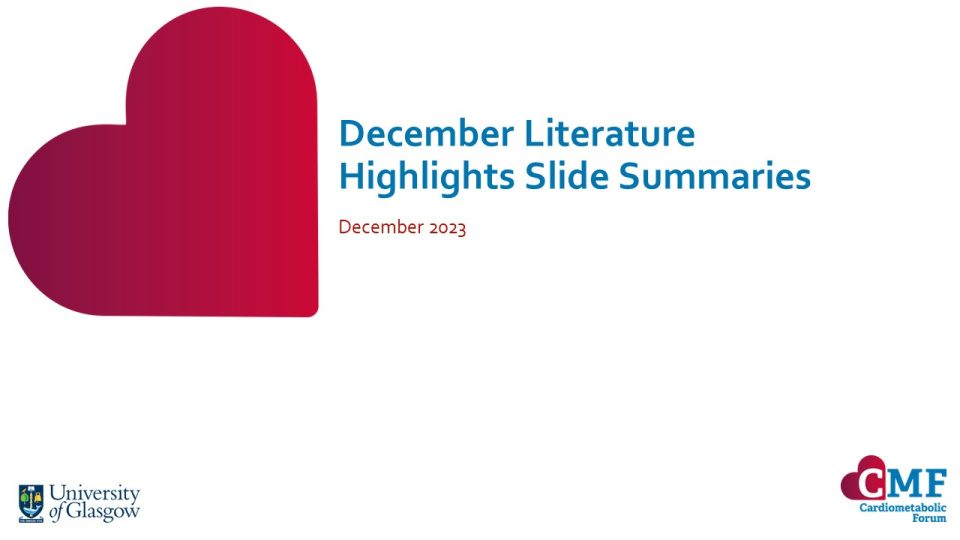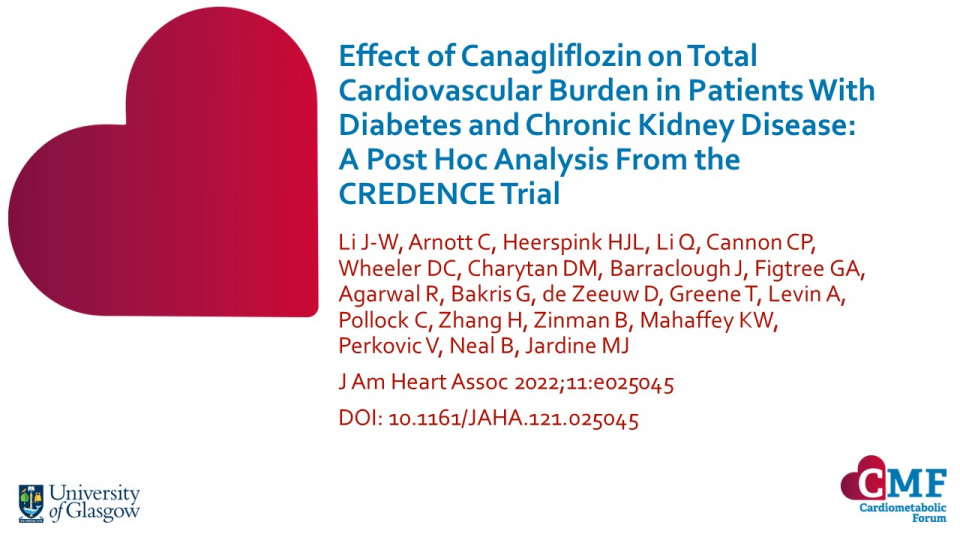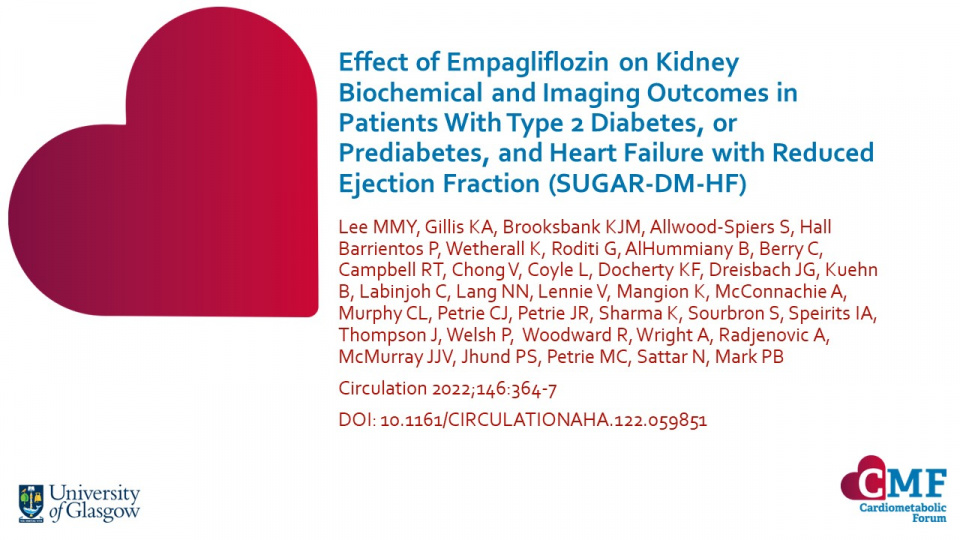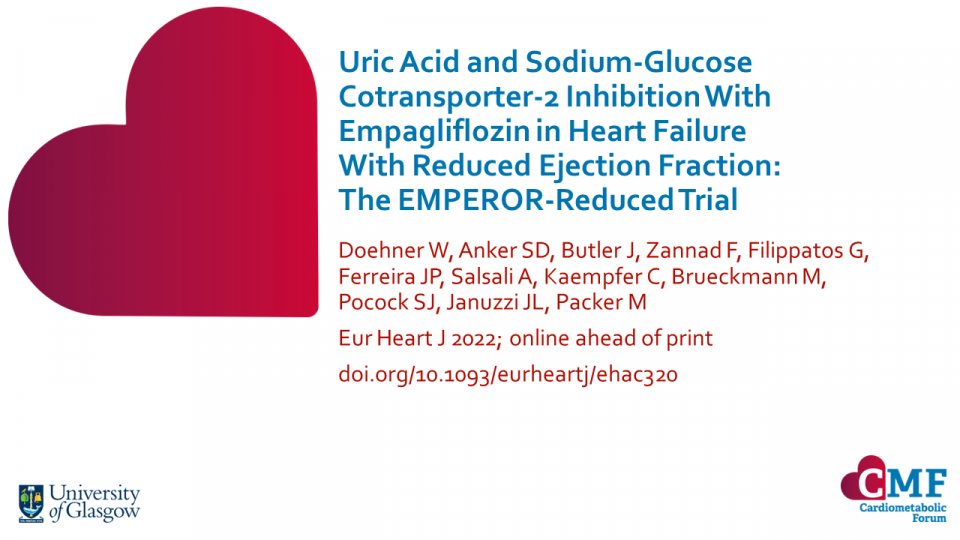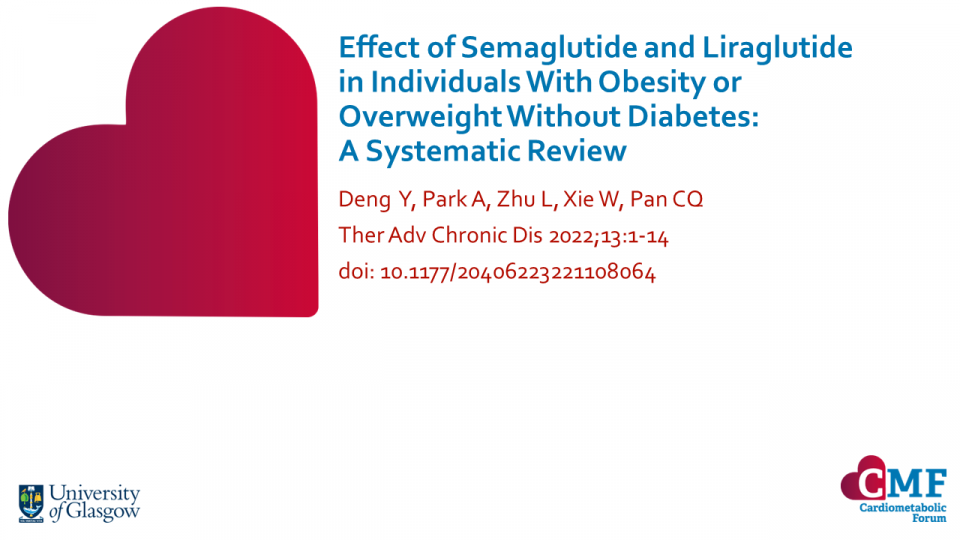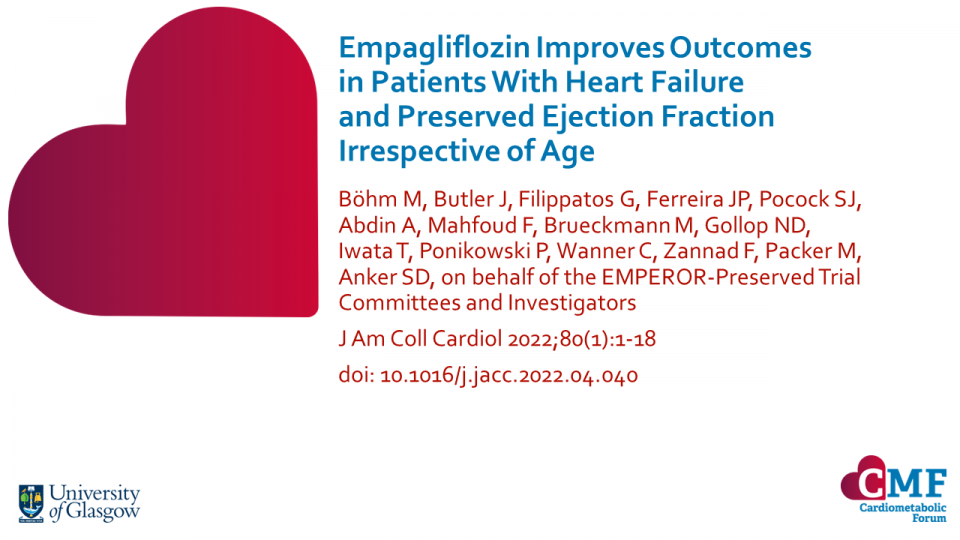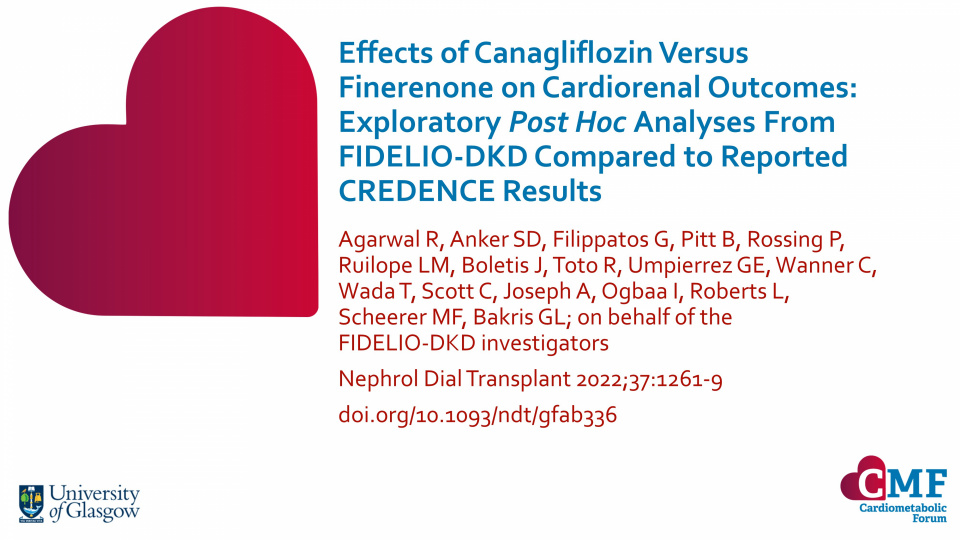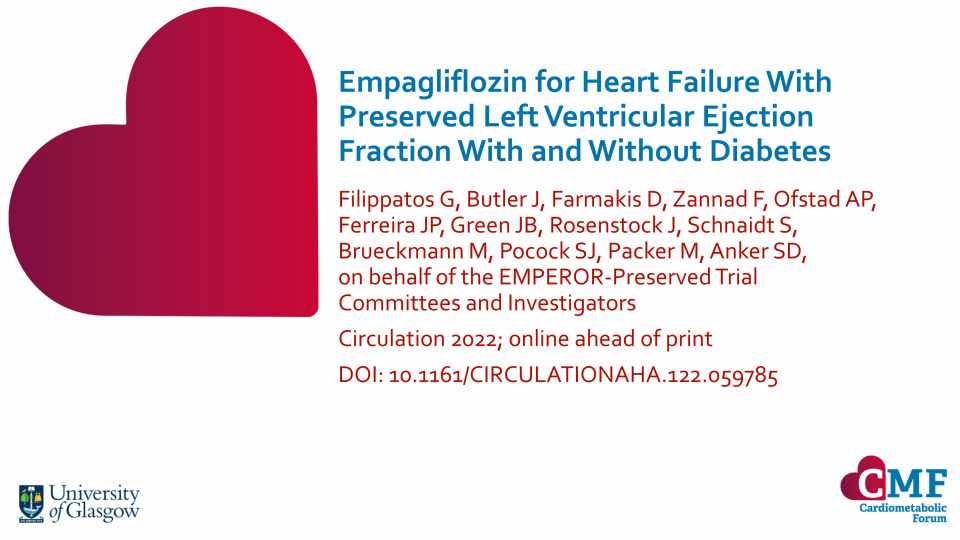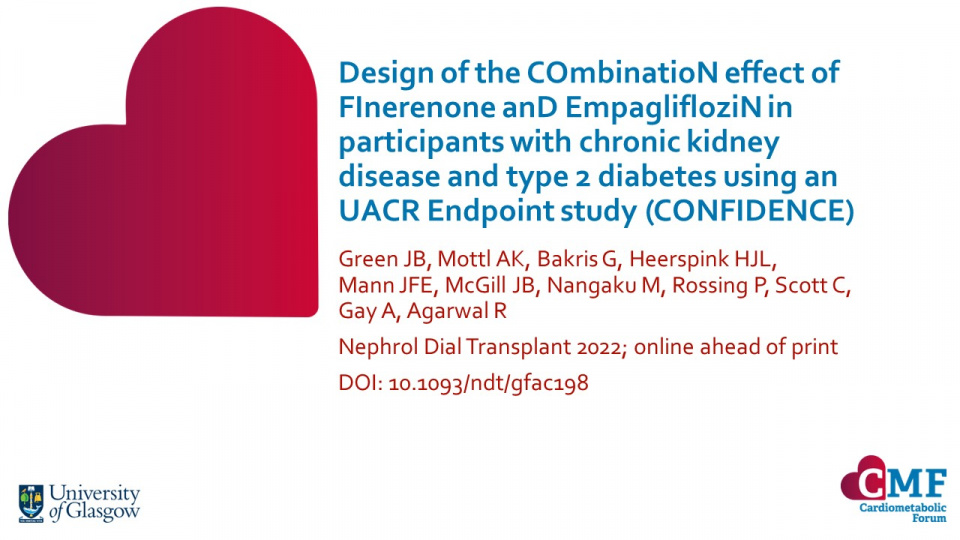Publications
Stay up to date with our literature reviews which are curated by experts to feature the most important publications released each month. Explore our publications for access to concise summary slides for your own use.
Effect of Canagliflozin on Total Cardiovascular Burden in Patients With Diabetes and Chronic Kidney Disease: A Post Hoc Analysis From the CREDENCE Trial
J Am Heart Assoc 2022;11:e025045 DOI: 10.1161/JAHA.121.025045
Cardiovascular disease is highly prevalent, and represents a major burden in patients with both T2D and CKD. In the CREDENCE trial, canagliflozin reduced the risk of first composite cardiovascular events; this post hoc analysis evaluated the effect on total (first and recurrent) events. During the trial, a total of 883 cardiovascular events occurred in 634 patients; 72% were first and 28% were subsequent events. Analysis showed canagliflozin reduced first and total cardiovascular events by 26% and 29%, respectively, with consistent results across patient subgroups and by baseline cardiovascular history.
These findings provide further support for the benefit of continuing canagliflozin therapy after an initial event to prevent recurrent CV events.
Iron Deficiency in Heart Failure and Effect of Dapagliflozin: Findings From DAPA-HF
Circulation 2022; online ahead of print DOI: 10.1161/CIRCULATIONAHA.122.060511
In this post hoc analysis of DAPA-HF, 43.7% of participants had iron deficiency at baseline, which was associated with worse outcomes. Dapagliflozin appeared to increase iron use but improved outcomes, irrespective of iron status at baseline.
Effect of Empagliflozin on Kidney Biochemical and Imaging Outcomes in Patients With Type 2 Diabetes, or Prediabetes, and Heart Failure with Reduced Ejection Fraction (SUGAR-DM-HF)
Circulation 2022;146:364-7 DOI: 10.1161/CIRCULATIONAHA.122.059851
This study found that a reduction in kidney perfusion and congestion may be mechanisms by which sodium-glucose cotransporter-2 inhibitors (SGLT2i) affect kidney function in people with heart failure with reduced ejection fraction (HFrEF). The authors believe this is the first kidney MRI trial using SGLT2i in this patient group.
Semaglutide in Type 2 Diabetes With Chronic Kidney Disease at High Risk of Progression: Real-World Clinical Practice
Clin Kidney J 2022;15(8);1593-600 doi: 10.1093/ckj/sfac096
In this real-world study, patients with type 2 diabetes (T2D) and chronic kidney disease (CKD) treated with semaglutide significantly improved glycaemic control and decreased weight.
Uric Acid and Sodium-Glucose Cotransporter-2 Inhibition With Empagliflozin in Heart Failure With Reduced Ejection Fraction: The EMPEROR-Reduced Trial
Eur Heart J 2022; online ahead of print doi.org/10.1093/eurheartj/ehac320
Hyperuricaemia is common in heart failure (HF) and is an independent predictor of advanced disease severity and increased mortality. This analysis from EMPEROR-Reduced showed that empagliflozin induced a rapid and sustained reduction of both serum uric acid (SUA) and of clinical events related to hyperuricaemia.
Effect of Semaglutide and Liraglutide in Individuals With Obesity or Overweight Without Diabetes: A Systematic Review
Ther Adv Chronic Dis 2022;13:1-14 doi: 10.1177/20406223221108064
This systematic literature review found liraglutide and semaglutide led to clinically relevant (≥5%) weight loss in 48.2–88.7% of obese or overweight adults without diabetes.
Data on the effects of liraglutide and semaglutide in diabetes are well-known, but therapeutic outcomes in obese or overweight individuals without diabetes have not been summarised. This systematic review aimed to evaluate their effects in this population, and 18 studies representing 10,938 patients were included.
Empagliflozin Improves Outcomes in Patients With Heart Failure and Preserved Ejection Fraction Irrespective of Age
J Am Coll Cardiol 2022;80(1):1-18 doi: 10.1016/j.jacc.2022.04.040
Sodium-glucose cotransporter-2 inhibitors (SGLT2i) reduce cardiovascular death and hospitalisation for heart failure (HHF) in patients with HFpEF, and are recommended in recent guidelines for heart failure with reduced ejection fraction (HFrEF), supported by Class IA evidence. Typically, HFpEF patients are older than HFrEF, and have a higher mortality risk associated with older age, while the risk for cardiovascular death is lower than in HFrEF. Until now, the treatment effects and safety of SGLT2i in relation to age have not been studied. This prespecified analysis of the EMPEROR-Preserved trial examined the interplay of age and empagliflozin treatment effects.
For patients on placebo, the incidence of primary outcomes and cardiovascular death increased with age. In contrast, empagliflozin reduced the primary outcome, first HHF, and first and recurrent HHF across all age groups. Empagliflozin also improved health-related quality of life, and attenuated the decline of eGFR without age interaction. Additionally, there were no clinically relevant differences in AEs between empagliflozin and placebo across the age groups, and elderly patients tolerated the treatment well.
Effects of Canagliflozin Versus Finerenone on Cardiorenal Outcomes: Exploratory Post Hoc Analyses From FIDELIO-DKD Compared to Reported CREDENCE Results
Nephrol Dial Transplant 2022;37:1261-9 doi.org/10.1093/ndt/gfab336
This analysis highlights the pitfalls of direct comparisons between trials, since when key differences in design are considered, FIDELIO-DKD and CREDENCE demonstrate similar cardiorenal benefits. The authors conclude that both canagliflozin and finerenone are similarly effective in reducing the risk of cardiorenal outcomes.
Empagliflozin for Heart Failure With Preserved Left Ventricular Ejection Fraction With and Without Diabetes
Circulation 2022; online ahead of print
In patients enrolled in EMPEROR-Preserved, empagliflozin significantly reduced the risk of heart failure (HF) outcomes irrespective of diabetes status.
Keywords:
Design of the COmbinatioN effect of FInerenone anD EmpaglifloziN in participants with chronic kidney disease and type 2 diabetes using an UACR Endpoint study (CONFIDENCE)
Nephrol Dial Transplant 2022 Jun 14;gfac198. Online ahead of print. doi: 10.1093/ndt/gfac198.
CONFIDENCE is a new trial currently recruiting. The aim is to demonstrate that 6 months’ dual therapy with finerenone and empagliflozin is superior for reducing albuminuria versus either agent alone.
Despite available interventions, people with T2D remain at risk of chronic kidney disease, which puts them at further risk of kidney failure, CV morbidity, and all-cause mortality. There is therefore a need to slow or attenuate the progression of chronic kidney disease (CKD) and reduce CV morbidity and mortality in this population.
Finerenone and sodium-glucose cotransporter-2 inhibitors (SGLT2i) can both reduce kidney and CV risks, acting via both shared and distinct pathophysiological pathways. Results from post hoc subgroup analyses and a preclinical model suggest dual therapy may provide additive renoprotective effects than using either class alone.

